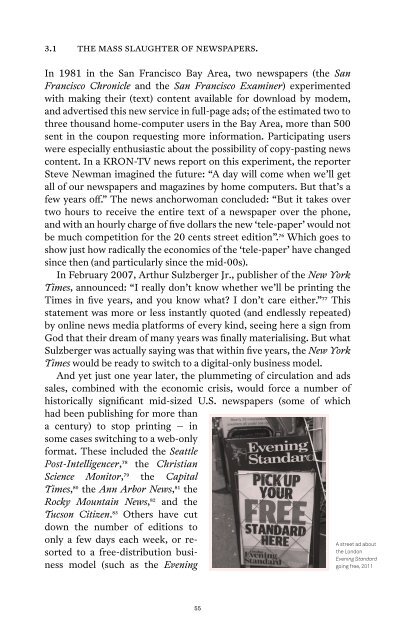Post- Digital Print - Monoskop
Post- Digital Print - Monoskop
Post- Digital Print - Monoskop
You also want an ePaper? Increase the reach of your titles
YUMPU automatically turns print PDFs into web optimized ePapers that Google loves.
3.1 the mass slaughter of newspapers.<br />
In 1981 in the San Francisco Bay Area, two newspapers (the San<br />
Francisco Chronicle and the San Francisco Examiner) experimented<br />
with making their (text) content available for download by modem,<br />
and advertised this new service in full-page ads; of the estimated two to<br />
three thousand home-computer users in the Bay Area, more than 500<br />
sent in the coupon requesting more information. Participating users<br />
were especially enthusiastic about the possibility of copy-pasting news<br />
content. In a KRON-TV news report on this experiment, the reporter<br />
Steve Newman imagined the future: “A day will come when we’ll get<br />
all of our newspapers and magazines by home computers. But that’s a<br />
few years off.” The news anchorwoman concluded: “But it takes over<br />
two hours to receive the entire text of a newspaper over the phone,<br />
and with an hourly charge of five dollars the new ‘tele-paper’ would not<br />
be much competition for the 20 cents street edition”. 76 Which goes to<br />
show just how radically the economics of the ‘tele-paper’ have changed<br />
since then (and particularly since the mid-00s).<br />
In February 2007, Arthur Sulzberger Jr., publisher of the New York<br />
Times, announced: “I really don’t know whether we’ll be printing the<br />
Times in five years, and you know what? I don’t care either.” 77 This<br />
statement was more or less instantly quoted (and endlessly repeated)<br />
by online news media platforms of every kind, seeing here a sign from<br />
God that their dream of many years was finally materialising. But what<br />
Sulzberger was actually saying was that within five years, the New York<br />
Times would be ready to switch to a digital-only business model.<br />
And yet just one year later, the plummeting of circulation and ads<br />
sales, combined with the economic crisis, would force a number of<br />
historically significant mid-sized U.S. newspapers (some of which<br />
had been publishing for more than<br />
a century) to stop printing – in<br />
some cases switching to a web-only<br />
format. These included the Seattle<br />
<strong>Post</strong>-Intelligencer, 78 the Christian<br />
Science Monitor, 79 the Capital<br />
Times, 80 the Ann Arbor News, 81 the<br />
Rocky Mountain News, 82 and the<br />
Tucson Citizen. 83 Others have cut<br />
down the number of editions to<br />
only a few days each week, or resorted<br />
to a free-distribution business<br />
model (such as the Evening<br />
55<br />
A street ad about<br />
the London<br />
Evening Standard<br />
going free, 2011

















